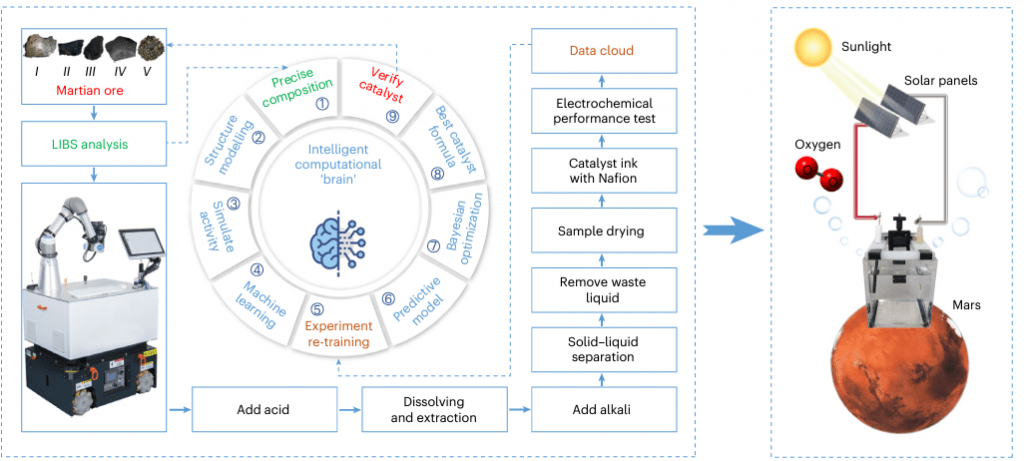Breaking oxygen out of a water molecule is a relatively simple process, at least chemically. Even so, it does require components, one of the most important of which is a catalyst. Catalysts enable reactions and are linearly scalable, so if you want more reactions quickly, you need a bigger catalyst. In space exploration, bigger means heavier, which translates into more expensive. So, when humanity is looking for a catalyst to split water into oxygen and hydrogen on Mars, creating one from local Martian materials would be worthwhile. That is precisely what a team from Hefei, China, did by using what they called an "AI Chemist."
Unfortunately, the name "AIChemist" didn't stick, though that joke might vary depending on the font you read it in. Whatever its name, the team's work was some serious science. It specifically applied machine learning algorithms that have become all the rage lately to selecting an effective catalyst for an "oxygen evolution reaction" by utilizing materials native to Mars.
To say it only chose the catalyst isn't giving the system the full credit it's due, though. It accomplished a series of steps, including developing a catalyst formula, pretreating the ore to create the catalyst, synthesizing it, and testing it once it was complete. The authors estimate that the automated process saved over 2,000 years of human labor by completing all of these tasks and point to the exceptional results of the testing to prove it.
Before we get to that, though, let's start with the "initial conditions." The team developed an "all-in-one" robotic AI chemist capable of performing all these tasks. It was initially based on work done by more limited AI chemists who could read synthetic chemistry literature and estimate the efficacy of different chemical compounds for different tasks. After they built the model, they needed to feed it with some data.
For that data, they selected five different common rocks from the surface of Mars. They estimated that there would be 3,764,376 possible combinations to come out of the elements present in those rocks, depending on how the combinations were manufactured. So, the first task of the AI Chemist was to select one that could act as a catalyst for splitting off oxygen. Part of that dataset was built with 30,000 other theoretical datasets and the results of 243 experiments. The result is a "polymetallic" material composed of manganese, iron, nickel, magnesium, aluminum, and calcium.
Next, a sample of the catalyst would be manufactured for testing. The AI is equipped with a robot arm that took physical samples of meteorites that had been dissolved in hydrochloric acid and attempted to synthesize the suggested catalyst out of those materials. This process involved pretty extreme processes like centrifuging the samples at 7,500g for 5 minutes to separate out the necessary materials and drying out the resultant material. Impressively, all of this was seemingly done without human intervention.
Fraser goes into detail about how a potential mission to Mars will happen in the near future - including creating oxygen using catalysts.After some of the material had been synthesized, the research team tested it by actually performing the reduction process it was designed to do. More importantly, they did so under Martian ambient conditions. The material performed admirably, similar to existing catalysts already used.
So, effectively, an AI just developed and tested a catalyst for use on Mars using local materials. And potentially saved over 2,000 years of intensive human labor in doing so. That is a testament to how effective AI is at finding patterns in existing data and extrapolating them using new data. It remains to be seen, though, if this catalyst will ever see the light of day on Mars, as the catalyst itself must be integrated with the rest of the system to perform the reduction reaction to split oxygen from water effectively. Given the complexity of the process used to create that catalyst, it might be easier for us to ship one directly from Earth, even if it doesn't use Martian materials.
Learn More:
Zhu et al. - Automated synthesis of oxygen-producing catalysts from Martian meteorites by a robotic AI chemist
UT - A Single Robot Could Provide a Mission To Mars With Enough Water and Oxygen
UT - What is ISRU, and How Will it Help Human Space Exploration?
UT - A new way to Make Oxygen on Mars: Using Plasma
Lead Image:
Series of images of the robotic arm used in the experiments running the catalyst synthesis process.
Credit - Zhu et al.
 Universe Today
Universe Today

